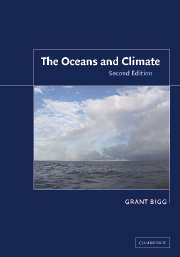Book contents
- Frontmatter
- Contents
- Preface to the first edition
- 1 The climate system
- 2 Physical interaction between the ocean and atmosphere
- 3 Chemical interaction of the atmosphere and ocean
- 4 Biogeochemical interaction of the atmosphere and ocean
- 5 Large-scale air–sea interaction
- 6 The ocean and natural climatic variability
- 7 The ocean and climatic change
- Appendices
- Glossary
- Bibliography
- Index
- References
3 - Chemical interaction of the atmosphere and ocean
Published online by Cambridge University Press: 05 June 2012
- Frontmatter
- Contents
- Preface to the first edition
- 1 The climate system
- 2 Physical interaction between the ocean and atmosphere
- 3 Chemical interaction of the atmosphere and ocean
- 4 Biogeochemical interaction of the atmosphere and ocean
- 5 Large-scale air–sea interaction
- 6 The ocean and natural climatic variability
- 7 The ocean and climatic change
- Appendices
- Glossary
- Bibliography
- Index
- References
Summary
Both the ocean and the atmosphere are composed of a mixture of chemical compounds, some inert but many chemically very reactive. The two fluids therefore conceal an almost infinitely varied chemistry, which the presence of living organisms complicates even further. We are largely unaware of the molecular-scale world, where these processes occur, as we go about our everyday lives. Nonetheless, its invisible activity contributes fundamentally to the climate system, as we saw in Chapter 1.
The vast subjects of atmospheric and oceanic chemistry are well beyond the scope of this book. We will confine ourselves in this chapter to those processes occurring at the interface between the two media, and chemical contributions to the climate originating from an oceanic source. Some of these intimately involve biological activity; most interact with life forms in some way. To make the topic manageable those components strongly linked to marine biological processes will be left to the next chapter. There will, however, be a number of recurring themes: examples are cloud processes and the nitrogen and sulphur cycles.
A major part of the chemical interaction between the atmosphere and ocean begins with the transfer of chemical species, particularly gases, from one fluid to the other. This process depends on a number of physical and chemical parameters. The resulting control of the supply of oxygen and carbon dioxide to the ocean and atmosphere respectively lies at the root of much of the discussion of this, and the next, chapter.
- Type
- Chapter
- Information
- The Oceans and Climate , pp. 91 - 121Publisher: Cambridge University PressPrint publication year: 2003



